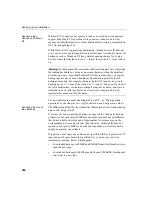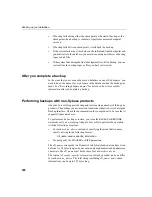
Backing up your database
380
Distribution of backup data
BACKUP
always makes a full backup of the Catalog Store on the first archive
device, and then backs up the data from the IQ Store in parallel across all of the
devices you specify. Blocks are not distributed evenly across archive media.
You may have more on one device than others, depending on the processing
speed of individual threads.
Note
The distribution of backup data is important because sets of files must be
restored in the order in which they were backed up. See “Restoring in the
correct order” on page 403 for more information.
Ensuring that your database is consistent
Although Backup does check that all necessary files are present before backing
up your database, it does not check internal consistency. For a more thorough
check, you can run the stored procedure
sp_iqcheckdb
before making a backup.
See “Validating your database” on page 393 for details.
Selecting archive devices
You can back up any IQ database onto either disk or magnetic tape. Adaptive
Server IQ supports backup and restore using multiple tape drives at near device
speeds, or to multiple disks if disk striping is in use. You specify the backup
device name in the archive_device parameter of the
BACKUP
command.
Disk backup requirements
Disk backups must go to a file system; raw disk is not supported as a backup
medium. All disks on a RAID device are treated as a single device.
Tape backup requirements
If you regularly back up large databases, you should use DLT drives, if they are
supported for your platform. In any case, Sybase recommends that you use
multiple tape drives.
Adaptive Server IQ
BACKUP
can support the following tape drives:
•
Digital Linear Tape (DLT) on UNIX systems
Summary of Contents for Adaptive Server IQ 12.4.2
Page 1: ...Administration and Performance Guide Adaptive Server IQ 12 4 2 ...
Page 16: ...xvi ...
Page 20: ...Related documents xx ...
Page 40: ...Compatibility with earlier versions 20 ...
Page 118: ...Troubleshooting startup shutdown and connections 98 ...
Page 248: ...Importing data by replication 228 ...
Page 306: ...Integrity rules in the system tables 286 ...
Page 334: ...Cursors in transactions 314 ...
Page 396: ...Users and permissions in the system tables 376 ...
Page 438: ...Determining your data backup and recovery strategy 418 ...
Page 484: ...Network performance 464 ...
Page 500: ...System utilities to monitor CPU use 480 ...
Page 514: ...Characteristics of Open Client and jConnect connections 494 ...
Page 536: ...Index 516 ...
















































